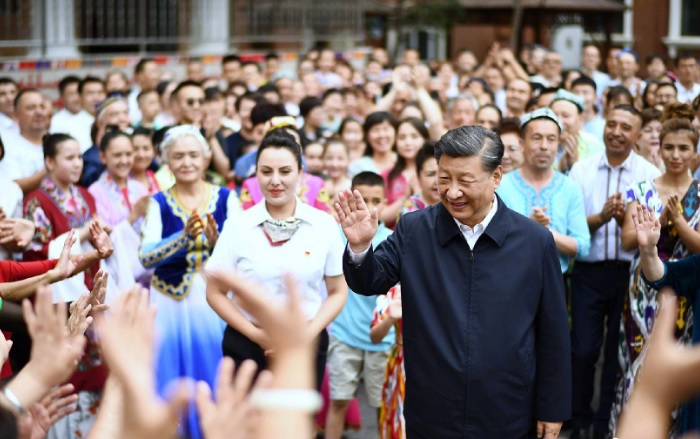Why would Chinese President Xi Jinping (習近平) hide his “visit to Xinjiang” last week from the Chinese people and the world, and why did Chinese state media not report the visit until Friday, a day after its conclusion?
No matter how powerful this killer is or how modern his weapons are, the magnitude and brutality of the crime he commits is so well known to himself that he cannot be free from the weakness of criminal guilt.
Xi’s first visit to the region in eight years took place from July 12 to 14, yet there was no statement issued by Chinese state media beforehand, nor was there any news of the journey reported. The reason for Xi’s lack of transparency is simple: He fears for the crimes that his regime has committed in the majority Muslim Uighur region over the past five years.
Chinese officials have repeatedly and proudly said that there has been no single violent incident in Xinjiang since the establishment of “vocational training centers.” If so, why was Xi afraid of publicizing his visit to a region where “zero violence” has supposedly been achieved?
The reason is that Xi has failed to achieve his goal. The roots of the problem still exist — the illegal occupation of Uighur land by the Chinese Communist Party (CCP) and its unjust ethnic policies in the region. Xi has fueled the problem with unprecedented crackdowns, including the incarceration of at least 1 million people, although some estimates put the figure as high as 3 million.
The CCP’s pursuit of “zero violence” provides only artificial stability. Xi is well aware of this and the inherent dangers of the policy.
In 2014, Xi ’s first visit to the region was welcomed by an explosion at the Urumqi train station. He could not have forgotten this historic event, so his latest visit might have been unannounced to leave potential attackers unprepared.
However, hiding his travel dates and itinerary did not provide him with adequate comfort or confidence. This fear was reflected in the pictures released by China’s official Xinhua news agency — a crowd of smiling and applauding Uighur residents surrounding Xi, mostly women and the elderly. There was a notable absence of young male residents.
What brought Xi to Xinjiang? Politically, he wants to tell the world that he does not regret the genocide he has committed and for which he has been criticized. He does not care about international public opinion. With this message, Xi wants to encourage China’s military, police forces and Han Chinese settlers in the region.
It is a macabre demonstration of the vile pleasure Xi apparently derives from having “successfully” concealed the thousands of corpses of those who have died within the camps and prisons superintended by his comrades.
Boasting of strength is normal, but boasting of crime is not. While most murderers in human history have tried to cover their guilt with reasons and excuses, China has no such tradition. Incarcerating all men of military age in a captured nation, and then boasting of a “zero-violence victory,” is unique to Chinese officials.
If China had won and formed this victory against the army of another world state or against armed rebel groups in the region, it would have been possible to think there was a moral side to this and a reason to be proud. In reality, it is a victory against a small and unorganized group of “terrorists” who have no weapons other than axes and knives.
Chinese state media showed Xi with a group of people who celebrated him by dancing and singing. Since the CCP’s occupation of East Turkestan, the Chinese state has always hoped to see Uighurs engaged in music and dance, but with no interest in politics.
They also dreamed of seeing Uighur Muslims who only pray but do not think of, or seek out, justice. That dream has not been realized, as it is incompatible with human nature. The Uighurs dancing around Xi are not reflective of the Uighurs’ situation. They represent a scene that China wants the world to see and an expression of China’s unwavering colonial desire.
To understand this scene of dancing, one must read only two lines of dialogue in a report by Radio Free Asia, during which a reporter questioned a Kashgar resident in 2011.
“How is the situation in Kashgar, especially the unity of Han [Chinese] settlers and Uighurs?” the reporter asked.
“The situation is normal. The unity of nationalities is wonderful because if we do not unite with the Han people, we will be imprisoned and shot,” the person responded.
Another indication of Xi’s fear was reported by Radio Free Asia. On the eve of Xi’s visit, “individuals for community correction” and Uighurs suspected of participating in religious activities were transferred from a number of districts in Urumqi to other places in southern Xinjiang for a month-long “legal education.”
It is likely that they were kept there until Xi had left Urumqi.
Xi’s non-announcement and the delayed reporting of his visit to Xinjiang — and the relocating of suspected Uighurs from Urumqi — is an acknowledgment of his failures. He has established peace in appearance, but not in essence.
Xi has captured Uighurs physically, but not spiritually. Murderers cannot live in spiritual peace forever, regardless of their “power” and “success.”
Kok Bayraq is a Uighur American.

